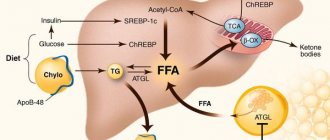Sign up
Price
Our doctors
- How do you get Hepatitis A?
- What are the symptoms of Hepatitis A?
- How is hepatitis A transmitted?
- Stages of Botkin's disease
- How to treat hepatitis A in a child
- How to treat hepatitis A in an adult
- How to treat chronic hepatitis A
- How to determine the presence of Botkin's disease
- What can you eat if you have hepatitis A?
- How to avoid getting hepatitis A
- Who to contact with hepatitis A
Hepatitis A or Botkin's disease is a medical term for a condition of acute damage to liver cells. The disease is caused by the virus of the same name (HAV) and is considered relatively safe for human life (compared to other types of hepatitis). The disease does not enter a protracted (chronic) stage; treatment of hepatitis A is quite productive, which leads to stable remission and subsequent complete cure.
TREATMENT OF HEPATITIS A IS AVAILABLE IN BRANCHES:
Treatment of hepatitis A in the Primorsky region
Address: St. Petersburg , Primorsky district, st. Repisheva, 13
Treatment of hepatitis A in the Petrograd region
Address: St. Petersburg , Petrogradsky district, st. Lenina, 5
Treatment of hepatitis A in Vsevolozhsk
Address: Vsevolozhsk , Oktyabrsky Prospekt, 96 A
The main symptom of hepatitis A is yellowing of the skin, which is why the disease is popularly called “jaundice.”
Causes of hepatitis A (Botkin's disease)
“Disease of dirty hands” is exactly the definition given by doctors around the world to this condition. Hepatitis A occurs only through contact with a sick person. The virus excreted in feces during the incubation period of the disease is most active. Hepatitis of the icteric or erased form is often completely asymptomatic; the person does not understand that he is sick, being a source of infection for those around him and random people who come into contact with the patient’s waste products. People do not see a doctor for a long time, which aggravates the course of the disease and complicates the treatment of hepatitis A. Mortality from this condition is observed in only 0.5% of situations.
In 40% of cases, the hepatitis A virus causes the development of other hepatitis.
Preventive recommendations
To avoid Botkin's disease or reduce the risk of developing it, it is recommended to adhere to the following tips:
- wash your hands before eating and after visiting public places;
- observe precautions when living with a patient with hepatitis A in the same area;
- drink water only from proven sources;
- have one sexual partner or use barrier protection (condoms) during casual intimacy;
- follow food preparation technology without reducing the time of exposure to high temperatures;
Hepatitis A is a disease with a favorable prognosis, but treatment should not be neglected. Thanks to timely diagnosis and therapeutic measures, it is possible to reduce the area of liver damage and quickly restore its functioning.
Symptoms of Hepatitis A (Botkin's Disease)
You can find out about the presence of hepatitis in the body by the following signs:
- a sharp increase in body temperature (38.5-39°C);
- the appearance of signs of intoxication of the body, such as dizziness, nausea, severe weakness, a feeling of aching in the joints, bones, muscles;
- atypical belching, vomiting for no reason;
- feeling of heaviness under the ribs on the right side;
- diarrhea or constipation;
- pain in the abdominal area;
- loss of appetite;
- general malaise and severe weakness;
- Sometimes there is a sore throat and pain when swallowing.
Together, these symptoms indicate hepatitis disease and require immediate initiation of therapy. Treatment of hepatitis A often begins only after the onset of severe jaundice: yellowing of the sclera and skin, darkening of urine and sharp lightening of stool - usually this occurs on days 3-5 of the disease.
The incubation period for hepatitis ranges from 14 to 42 days.
How to protect yourself from hepatitis B?
The only means of protection is vaccination against hepatitis B, which is currently administered to all newborn children and adolescents. Adults with risk factors for infection should also be vaccinated. The hepatitis B vaccine is one of the safest vaccines in the world. Three-time administration of the vaccine according to a special scheme leads to the formation of specific antibodies that prevent the development of hepatitis B disease in 98% of those vaccinated. Immunity lasts for at least 8-10 years, but often remains for life.
Routes of transmission of hepatitis A (Botkin's disease)
The main routes of transmission of hepatitis A are:
- water - when sewage gets into the water supply network or when swimming in lakes and reservoirs in the warm season;
- food – poorly washed fruits and vegetables, dirty hands;
- household items - toys, dishes, linen, etc.;
- sexually - infection with hepatitis A is transmitted in this way extremely rarely, mainly among homosexuals;
- through blood - also in rare cases (situations were noticed among drug addicts and in recipients who received blood from a carrier of the hepatitis virus).
This type of hepatitis A often occurs in the summer, when it is warm outside, people begin to eat more food outside the home and appear in public places more often. Children who are not familiar with the rules of personal hygiene suffer more from the disease. A huge percentage of patients are observed in underdeveloped countries of the world, where there are significant environmental problems.
Causes
The disease is of infectious origin. It is caused by a virus that, upon entering the body, affects the liver and leads to the death of hepatocytes. Infection can occur:
while swimming in a polluted body of water and swallowing water;- when consuming contaminated products;
- when using an infected needle;
- during intimacy (more typical for homosexuals);
- when drinking poorly purified water;
- when using household items (dishes, towels) together with the patient. To avoid the spread of infection, the latter must be isolated throughout the jaundice. The dangerous period is the end of the incubation period and the height of pathology;
- when consuming infected marine life (shellfish).
The risk of infection increases when traveling to hot countries, as well as when hygiene rules are not followed.
The virus is an RNA pathogen and has good resistance to unfavorable conditions.
Stages of Botkin's disease
Hepatitis A in stage 1 is invisible, since the patient does not even understand that he is sick. The duration of the period is 14-42 days (depending on the person’s immunity and aggravating factors, the average is 28 days). At this time, treatment for hepatitis A is not carried out, since the disease is asymptomatic and does not manifest itself in any way.
At the next stage, which lasts from the moment the disease is detected to 54 days, the first symptoms appear:
- general weakness, deterioration of health, fatigue;
- pain in muscles and joints;
- pain in the right side, a feeling of tightness under the ribs in the liver area;
- liver enlargement;
- loss of appetite, dyspeptic disorders;
- itching of the skin.
In children, all these symptoms may be mild or completely absent.
At the third stage, hepatitis is complicated by infection with the HAV virus with characteristic symptoms:
- yellowing of the skin and sclera (“jaundice”);
- discoloration of stool;
- brown urine.
This stage occurs from days 54 to 90. At the first sign of yellowing, treatment for hepatitis A should be started immediately.
Complications
Hepatitis A rarely causes complications; usually the disease ends in complete recovery. The most severe complication of Botkin's disease is liver failure. After recovery from hepatitis A, strong immunity usually remains and re-infection is not possible. However, if treatment is not completed and complete recovery does not occur, a second wave of the disease may occur - a relapse. This happens in 15% of people with Botkin's disease and can occur repeatedly.
Liver failure is a rare and potentially life-threatening complication of hepatitis in which the liver may stop functioning normally. The following groups of people are usually affected by it:
- people with weakened immune systems (as a result of a chronic disease such as diabetes or a side effect of certain treatments such as chemotherapy).
- people with existing liver disease such as cirrhosis or hepatitis C (a more severe type of hepatitis);
Some symptoms of liver failure are similar to those of hepatitis A and include jaundice, nausea and vomiting.
Treatment of hepatitis A (Botkin's disease) in children
Therapeutic activities for children of different ages are carried out taking into account the stage and neglect of the process. Usually it is necessary to place the child in a hospital, where hepatitis A will be treated in accordance with the norms and rules of SanPiN. This prevents the spread of infection and cuts off routes of infection. Each child is housed separately in the hospital to prevent cross-transmission of the virus to each other. This greatly facilitates the process of treating hepatitis A in children, especially younger ones.
Therapy includes strict bed rest during the acute period. This treatment of Botkin's disease lasts until the color of urine normalizes and laboratory blood tests improve.
To alleviate the condition of intoxication, treatment of viral hepatitis A with detoxification agents is prescribed: saline solution and glucose solution intravenously. Patients take sorbents internally: activated carbon, Enterosgel, Filtrum, etc.
Hormonal therapy is not usually used in pediatric therapy, but is relevant for malignant progression and exacerbation of the process. If children show severe damage to liver cells (which can be seen if they are tested for hepatitis A and monitor the increase in enzyme levels by 5 or more times), the doctor additionally prescribes antiviral drugs. Usually “Interferon”, “Viferon”, “Raferon-A” and others are used.
Hepatitis A in children is often treated with the help of immunomodulators: Decaris, Cycloferon, Tactivin, etc.
To support the patient’s liver, hepatoprotectors are used: “Essentiale N”, “Essentiale Forte”. Thanks to the phospholipids they contain, treatment of hepatitis A proceeds faster due to the restoration of liver cells. Herbal preparations will also help in treating the disease: “Karsil”. "LIV 52", "Legalon" and others.
To speed up the restoration of the body's defenses, vitamin complexes and restoratives are taken. Some children are prescribed choleretic drugs: “Cholenzim”, “Hofitol”, etc.
Kinds
The following forms of viral hepatitis A are known:
- icteric;
- with erased jaundice;
- anicteric.
A separate subclinical (inapparent) form is distinguished, which is diagnosed only on the basis of laboratory test results.
The course of the disease can be acute, protracted, subacute and chronic (extremely rare). According to the severity of clinical manifestations, acute infectious hepatitis can be mild, moderate and severe.
Treatment of hepatitis A (Botkin's disease) in adults
After identifying the disease, it is necessary to limit communication with others, ideally to go to the hospital for the entire acute period. Treatment of hepatitis A in adults is carried out practically according to the same scheme as in children. This is the organization of bed rest, which is highly not recommended to be violated, the complete cessation of open communication with others, and the implementation of all doctor’s recommendations.
Timely seeking help from a doctor and taking a blood test for hepatitis A can determine the presence of concomitant diseases (including infection with other hepatitis viruses). If the immune system is strong and the body’s protective functions work as expected, special treatment for hepatitis A in adults is not necessary. In cases where the disease has seriously affected the patient’s well-being, the doctor prescribes the following medications:
- enterosorbents for detoxification and removal of toxic substances from the body - they allow you to relieve liver cells from additional stress (in this case, hepatitis A should be treated with the help of Ringer-Locke solutions, glucose, Atoxil and others);
- hepatoprotectors - the drugs include Hepatosan, Legalon, Ursonan, etc.;
- vitamins – B vitamins are especially important;
- medications to relieve symptoms.
A drug called ursodeoxycholic acid in the form of pharmaceuticals “Ursodex”, “Urosan”, etc. will help improve liver function.
Symptomatic treatment of hepatitis A is prescribed separately in each case. If the patient is bothered by nausea and vomiting, he is prescribed antiemetics, and for pain, painkillers. To improve general well-being, vitamin preparations and immunomodulatory complexes are used. If hepatic encephalopathy develops, corticosteroids are prescribed.
Treatment of Botkin's disease has a favorable prognosis, liver functionality is usually completely restored.
Why is jaundice dangerous?
Complications of Botkin's disease for newborns are extremely severe, and therefore require immediate hospitalization and intensive care. In older age, the disease occurs in a milder form, but the risk of undesirable consequences is still present. They are expressed:
- inflammation of the pancreas;
- joint damage (arthritis);
- inflammation of the mucous membrane of the digestive tract;
- vasculitis;
- renal dysfunction, which is expressed by nephrotic syndrome;
- inflammation of the organs of the hepatobiliary system.
Sometimes secondary infection, development of liver failure and encephalopathy are observed.
Consequences of jaundice in men
There is an opinion that Botkin's disease can cause infertility, but convincing evidence of this theory has not yet been provided. The pathogenesis of the development of this complication has not yet been established, therefore, in case of unsuccessful attempts to conceive, the cause should not be sought in viral liver damage.
Jaundice is just as dangerous for men as it is for women. The severity of complications depends on concomitant diseases and lifestyle.
Given the prevalence of alcoholism among the stronger sex, Botkin's disease can quickly lead to liver failure. The fact is that the breakdown products of alcohol have a toxic effect on hepatocytes, which is why they gradually die. Viral infection due to alcoholism can lead to decompensation of the gland, up to complete failure. Note that cirrhosis develops faster in men.
The stronger sex is less inclined to follow a dietary diet, as a result of which the affected hepatocytes in Botkin's disease experience additional stress (fatty, spicy foods). This can result in liver failure due to irreversible cell death.
Consequences of Botkin's disease in women
According to statistics, the weaker sex more often suffers from cholecystitis, cholangitis and bile duct dyskinesia. From this it follows that hepatitis A can provoke an exacerbation of chronic diseases of the biliary tract.
On the other hand, women are more susceptible to hormonal fluctuations. They can be caused by endocrine pathology, taking oral contraceptives, stress and pregnancy. All this affects metabolic processes, resulting in an increased risk of obesity and the progression of related diseases.
Treatment of chronic hepatitis A (Botkin's disease)
Hepatitis A is completely curable with well-designed therapy and does not progress to a long-term (chronic) stage. There may be a complication caused by a global disruption of the liver and the inability to establish its normal functioning for a long period (from 1-2 years to decades) after the illness. Treatment of chronic hepatitis A in this case is symptomatic and is aimed at restoring damaged liver cells, improving the functioning of the gallbladder, monitoring the patient’s general well-being and diet, especially in the acute period.
Is it necessary to follow a diet for patients with chronic hepatitis B?
No special diet is required for chronic viral hepatitis, however, you should avoid drinking alcohol even in small doses, since the combined effect of alcohol and the virus on the liver significantly increases the risk of developing cirrhosis and liver cancer. If you are overweight, you should limit your intake of fats and high-calorie foods, since fat deposition in the liver accelerates the development of cirrhosis. Factors that reduce immunity, in particular sun exposure, should be avoided, that is, you should not use a solarium or sunbathe on the beach. It is advisable to quit smoking. You can continue to exercise. Swimming and hardening procedures that support the state of your immunity are useful.
Diagnosis of hepatitis A
Before starting treatment for hepatitis A, it is necessary to diagnose the disease and determine at what stage of development it is. The disease is diagnosed by an infectious disease doctor who will suggest testing for hepatitis A. In most cases, diagnosis is carried out in several stages:
- interviewing or collecting anamnesis from the patient or his relatives (for children);
- conducting a blood test for hepatitis A (detection of virus markers);
- biochemical blood and urine tests;
- examination of the abdominal cavity using ultrasound.
After this, treatment for hepatitis A is prescribed and monitoring of the patient during the recovery period is organized.
Diagnostics
Diagnosis of hepatitis A is based on clinical signs of the disease: liver enlargement, jaundice and other symptoms. The doctor also takes into account epidemiological factors, that is, how the infection is contracted (drinking unboiled water, products of unknown purity, and so on).
Laboratory tests are crucial. Disease-specific tests:
- polymerase chain reaction to detect viral genetic material;
- enzyme immunoassay for detecting antibodies to pathogens of the IgM class.
If only IgG antibodies are detected in the body, this indicates a previous disease or immunity to it. The chronic form of the disease does not occur, but there are cases of healthy virus carriers.
Nonspecific laboratory signs of the disease in women and other groups of patients are necessary to assess the severity of the infectious process and the effectiveness of prescribed drugs:
- ALT and AST;
- bilirubin and its fractions (direct, indirect);
- serum protein level, fibrinogen.
Ultrasound is used to determine the size of the liver.
Diet for hepatitis A
As with some other liver diseases, treatment of hepatitis A is impossible without following a strict diet. Without this, the weakened liver will not cope with the load placed on it and will not be able to process even those familiar foods that were previously in the diet constantly. To make it easier to treat hepatitis A, and the disease went away faster, Soviet-era specialists developed a special diet, which received the official name “Table No. 5.” Her recommendations are still followed today, despite the abundance of goods on store shelves. It is better to avoid modern food products of imported and domestic production. This is easily explained: new generation products often contain preservatives, dyes, and food additives that have a detrimental effect on even perfectly healthy liver cells.
Table No. 5: which foods should be completely excluded?
If you have hepatitis A, you should completely avoid alcohol. The use of tobacco and narcotic, potent and certain medications also needs to be stopped. During treatment for viral hepatitis A, you should not eat fried, smoked, salty or fatty foods. Pickled foods, fatty meats, and any fast-cooking foods are removed from the diet.
Products such as chips, crackers, instant foods, carbonated water and other drinks with dyes are strictly prohibited during the period of treatment for hepatitis A and for at least six months after recovery.
What can you eat?
- Meat or fish (it is better to choose low-fat varieties), steamed or boiled;
- dairy and fermented milk products: kefir, 10-15% sour cream, yogurt without additives, cottage cheese;
- stewed or fresh vegetables;
- lean soups, sometimes borscht is allowed;
- egg whites (better cooked in a steam omelet);
- homemade crackers without salt or other flavor enhancers;
- yesterday's bread;
- weak black, green or herbal tea (with or without milk), compotes, jelly and homemade juices (from sweet fruits and berries), chamomile or rose hip decoction, still mineral water.
It is impossible to treat hepatitis A without following a diet; this can lead not only to disruption of the liver, but also to its complete stop, which will lead to disastrous consequences for the patient.
Hepatitis
Infectious diseases occupy a significant place among all human diseases and among the causes of mortality throughout the world. In the 20th century, humanity eliminated only one infection—smallpox—and discovered 36 new infectious diseases. The cause of these diseases is the entry into the body of living microorganisms: bacteria, viruses or protozoa. Today, in terms of its socio-economic significance, that is, in terms of damage caused to people’s health, material costs of providing medical care, and labor losses, viral hepatitis . This group includes diseases that are different in their origin, modes of transmission, course and outcomes, but they were artificially combined due to the fact that they are all accompanied by inflammation of the liver. Even relatively recently, until the sixties of the last century. When the viral nature of these infections was discovered, they were called Botkin's disease, named after the famous doctor who described this disease. When a person of the older generation says that he suffered Botkin's disease, this means that he suffered as a result of infection with one of the hepatitis viruses, the causative agents of which were unknown at that time; they were discovered later.
Today, in the group of infectious hepatitis, there are at least six independent diseases that differ in the properties of their pathogens, causes of occurrence, clinical manifestations and outcomes. Currently, they are called by pathogens designated as hepatitis viruses, using the Latin letters A, B, C, D, E, G.
There are other hepatitises, the causative agents of which are poorly studied or have not yet been identified. Each virus has only its own properties. Having contracted one of the viral hepatitis does not exclude the possibility of infection with any other.
According to the main signs and characteristics, viral hepatitis can be divided into two groups. Hepatitis A and E are characterized by a fecal-oral mechanism of infection - through water, food, and as a result of household contacts. Hepatitis B, C, D and G are characterized by so-called parenteral transmission of the virus - through damaged skin, mucous membranes with infected blood. The second group is distinguished by a tendency to a protracted and chronic course. Separately, all viral hepatitis have their own characteristics. Knowing them in general terms is useful for every person. This will allow you to consciously follow the rules of behavior that prevent infection. All known hepatitis viruses are registered among the population living in Russia. Russia is one of the regions of the world with an average prevalence of hepatitis A, B, C and D and a low prevalence of hepatitis E.
Hepatitis A
Hepatitis A is a widespread infection. In the early 70s, the World Health Organization legalized the current name of the disease; before that time it was called Botkin’s disease, infectious jaundice, epidemic hepatitis, etc.
This infection is found everywhere.
Who causes the disease?
The causative agent of hepatitis A is the hepatitis A virus (in medical literature it is abbreviated as HAV) - an RNA virus that was discovered recently, and to date more than 30 of its varieties have already been described. The hepatitis A virus is considered one of the most resistant to environmental influences and is well preserved in it; when boiled, it dies after 5 minutes.
How can you get infected?
A person can become infected with hepatitis A through the mouth by consuming contaminated water or food; in children, this happens when toys and other objects get into the mouth, as well as dirty hands. Having penetrated the human body, the hepatitis A virus intensively multiplies in the liver, from there through the bile ducts it enters the intestines and then into the external environment. The spread of the virus and, accordingly, an increase in the risk of infection is facilitated by the unsatisfactory sanitary condition of the home and place of work, inappropriate personal hygiene rules, overcrowding of the population, as well as violation of the rules of food preparation and storage. Serious shortcomings in providing the population with good-quality drinking water lead to the spread of hepatitis A.
How does the disease manifest?
The clinical manifestations of the disease are very diverse: from imperceptibly occurring anicteric forms to severe illness with jaundice. From the moment of infection to the appearance of symptoms, an average of 3-4 weeks passes, in rare cases up to 7 weeks. The onset of the disease is acute. There is a short-term increase in temperature (2-3 days) to 38-38.5°C, moderate headache, and muscle pain. At the same time, appetite decreases, bitter belching, nausea, vomiting, weakness, fatigue, dull pain in the epigastric region and right hypochondrium appear. On the 5th-7th day of illness, icteric staining of the sclera, mucous membranes and skin appears. As a rule, with the appearance of jaundice the patient’s well-being improves. During the icteric period, urine becomes dark yellow or brown (the color of dark beer), and feces become discolored. Often patients themselves note the appearance of a jaundiced coloration of their skin, which forces them to see a doctor.
Diagnostics.
A biochemical analysis of blood and urine helps to make a diagnosis, but the final diagnosis (due to the similarity of manifestations in the acute period of all viral hepatitis) is made only on the basis of special immunodiagnostic methods.
Treatment
Treatment must be carried out in a hospital. Bed rest, diet, vitamins, and infusion therapy are prescribed.
Outcome of the disease:
In the vast majority of cases, hepatitis A, regardless of the severity of the course, ends with complete recovery of the patient and restoration of his liver function. The transition from acute to chronic hepatitis is not observed, complications are rare. With hepatitis A, there is no long-term carriage of the virus in the body after recovery.
Who is most at risk of infection:
-children and adolescents in closed or semi-closed groups;
- workers servicing sewer systems;
-organized contingents, for example, units of the armed forces, which are sent to regions with unsatisfactory sanitary conditions.
What helps reduce the incidence of hepatitis A?
-creation of satisfactory sanitary and hygienic living conditions;
-quality water supply;
- modern arrangement of children's and adolescent institutions;
- compliance with the regime at public catering establishments;
-compliance with personal hygiene rules.
Personal prevention measures:
— Never use water from random sources and reservoirs. In the absence of a reliable source of water, it must be boiled not only for drinking purposes, but also for washing vegetables and fruits.
— When identifying a patient with hepatitis A, you should follow the recommendations of doctors to isolate the patient and carry out disinfection at home. Recently, in some professional groups, as well as among people traveling to areas with high incidence, vaccination against hepatitis A has begun.
— When contacting a patient, immunoglobulin administration is practiced in children's institutions and families. You should not refuse the offer to administer it to your child; the protective effect of this drug has been proven, as well as its harmlessness.
Hepatitis B
This infection, caused by the hepatitis B virus, is a common human disease. Until the 70s it was called serum hepatitis. The disease is characterized by a variety of clinical manifestations and outcomes. In clinically pronounced cases, symptoms of acute liver damage and intoxication are characteristic.
The disease can occur unnoticed, in an anicteric form and is often not diagnosed. For every 1 icteric hepatitis there are 5-6 anicteric (atypical) hepatitis. Hepatitis B is characterized by asymptomatic virus carriage, which causes certain difficulties in preventing this infection. A person can remain a carrier of the virus for life.
Who causes the disease?
The causative agent of the disease is a DNA virus that is very resistant to high temperatures. The peculiarity of the pathogen is its high contagiousness, higher than that of HIV infection. The virus is stable in the external environment: at room temperature - up to 3 months, in the cold season - up to 6 months, when frozen - up to 15 years.
Who is the source of infection?
The source of infection is patients with acute, protracted and chronic forms of the disease, as well as virus carriers.
How can you get infected?
Infection with the hepatitis B virus occurs when it enters the bloodstream through natural and artificial means:
- Natural routes of transmission:
- sexual tract. During sexual intercourse, regardless of the method of its implementation, through semen, vaginal discharge and blood (microscopic, invisible to the eye injuries to the surface of the genital organs and rectum). All this is possible during unprotected sex, and much more often during homosexual contacts. For obvious reasons, an increased risk of infection exists among people who are promiscuous and prostitutes.
- vertical path - from mother to child during pregnancy, during childbirth and after childbirth, during child care and breastfeeding.
— transmission of the virus is also possible through close household contacts, through blood-contaminated razors, toothbrushes, washcloths, etc. In addition, transmission of the virus is possible during work activity - through abrasions, invisible microtraumas.
- Artificial routes of transmission of infection are associated with medical procedures, such as injections, surgeries, and also during the provision of dental care. The virus can be transmitted through blood-contaminated needles, instruments, blood transfusions, as well as through tattooing and piercing. People who use drugs through intravenous injection are especially susceptible to infection.
How does the disease manifest?
There are acute and chronic course of the disease, as well as virus carriage.
Acute course. The period from infection to the onset of the disease can last from 30 days to 6 months (most often 60-120 days). This circumstance complicates the establishment of the possible cause of the disease. The onset of the disease is often gradual. The following come to the fore: loss of appetite, nausea, vomiting, heartburn, belching, dull pain in the epigastrium. After 2-3 weeks, the urine darkens, the feces become light, jaundice appears, digestive disorders and intoxication symptoms intensify: weakness, fatigue, headache, apathy, irritability. Possible skin itching. The disease can occur in an anicteric or erased, weakly expressed form, which is difficult to suspect and can only be detected with the help of special laboratory tests.
Chronic forms are characterized by a change in the active course of the disease with its extinction, but with a gradual deterioration of the condition, the development of cirrhosis of the liver and, in 90% of cases, the death of patients.
Diagnostics.
A biochemical analysis of blood and urine helps to make a diagnosis, but the final diagnosis (due to the similarity of manifestations in the acute period of all viral hepatitis) is made only on the basis of special immunodiagnostic methods.
Treatment
Treatment must be carried out in a hospital. Bed rest, diet, vitamins, and infusion therapy are prescribed.
Outcome of the disease
In most cases, acute hepatitis B ends in recovery. In a small proportion of patients (10%), the disease can take a protracted course. If the disease lasts more than 6 months, it is regarded as chronic hepatitis.
Prevention
Measures to prevent the transmission of the hepatitis B virus and pathogens of other infections with a similar transmission mechanism are regulated in the documents of the Ministry of Health of the Russian Federation.
— special attention is paid to monitoring blood donors. All transfused blood is subject to mandatory laboratory testing for the presence of hepatitis B, C, AIDS, etc. viruses.
— examination of pregnant women, patients with sexually transmitted diseases, drug addicts, prostitutes, conducting anonymous examinations.
— the use of disposable needles, syringes, and other instruments eliminates the possibility of transmitting infection.
— Vaccination is an effective preventive measure against hepatitis B. In our country, since 1996, the so-called specific prevention of hepatitis B began, that is, the introduction of a vaccine among newborns and adolescents. By order of the Russian Ministry of Health, vaccination against hepatitis B was included in the National Calendar of Preventive Vaccinations in 1997, which is enshrined in the Federal Law “On Immunoprophylaxis of Infectious Diseases.” In 2006-2007 As part of the national project, the population is immunized against hepatitis B.
Hepatitis C
Hepatitis C is the most severe form of viral hepatitis, which is also called post-transfusion hepatitis or non-A non-B hepatitis. This means that they became ill with it after a blood transfusion, since testing donor blood for the hepatitis C virus began only a few years ago, when laboratory methods for detecting the hepatitis C virus appeared.
The causative agent of the disease is the hepatitis C virus, which is highly variable. Protective immunity is not developed to it and this does not allow the creation of a vaccine to prevent hepatitis C.
Infection occurs in the same way as with hepatitis B, through blood, sexual contact and from mother to fetus. Quite often, infection occurs through syringes among drug addicts.
The period from infection to the appearance of the first symptoms of the disease is from 3 weeks. up to 6 months The disease can occur with or without jaundice. The clinic of acute hepatitis C is similar in its clinical manifestations to the clinic of hepatitis B. The greatest danger is the chronic form of this disease, which often develops into cirrhosis and liver cancer. The chronic course develops in approximately 70-80% of patients and its development does not depend on the severity of the acute disease, it occurs gradually, over a long period of time (up to 20 years). When hepatitis C is combined with other forms of viral hepatitis, the disease becomes more severe and can result in the death of the patient.
Prevention includes the same measures as for hepatitis B, with the exception of vaccination.
Hepatitis D
Hepatitis D or delta infection is characterized by a more severe course than other viral hepatitis. A prerequisite for its development is the presence of the hepatitis B virus in the body. It has been established that about 5% of hepatitis B virus carriers are also infected with the D virus.
The causative agent of the disease is a virus that does not have its own envelope and realizes itself only in the presence of a helper virus, that is, the hepatitis B virus.
The source of the disease is sick people or virus carriers.
Infection with hepatitis D occurs only when the virus enters directly into the bloodstream naturally (sexually, from mother to child during pregnancy, through close household contacts) or artificially (during injections or other medical procedures, intravenous drug administration). The virus enters the liver through the bloodstream, where it multiplies, leading to the development of an acute disease.
From the moment the D virus enters the body until the onset of illness, 8-10 weeks pass. The disease is characterized by a more pronounced acute onset, with symptoms characteristic of many other diseases: fatigue, decreased appetite, nausea, vomiting, fever. And only with the appearance of a yellow color of the skin and sclera, dark urine and light-colored stool, an increase in intoxication and the appearance of pain in the right hypochondrium (in the liver area), allows an accurate diagnosis to be made, confirming it with laboratory tests. Hepatitis D is characterized by bleeding gums, nosebleeds, and bruising due to minor injuries, which is associated with impaired formation of blood clotting components in the liver.
The disease often becomes chronic, followed by the development of liver cirrhosis.
Prevention, as with hepatitis B.
Hepatitis E is similar to hepatitis A, but it starts gradually and is more dangerous for pregnant women. The last in the hepatitis family, hepatitis G , is similar to C but less dangerous.
PREVENTION OF HEPATITIS
1. Today, the most accessible and reliable method of prevention is vaccination. Vaccination of newborns has been carried out since 1984 in more than 100 countries around the world. There are vaccines against hepatitis A and B. Vaccination against hepatitis B is included in the National Vaccination Schedule. The vaccine is administered intramuscularly (into the deltoid muscle) according to the 0-1-6 scheme, i.e. twice with an interval of 1 month and subsequent revaccination 6 months after the first administration of the vaccine. The production of antibodies is observed in 94% of vaccinated people. In addition, vaccination against hepatitis B was included in the program of the priority national project “Health” for 2006-2007 with the goal of not only reducing the frequency of new cases of infection, but also significantly reducing the number of long-term consequences of infection with the hepatitis B virus.
2. To avoid infection of family members, it is necessary to observe basic rules of personal hygiene - individual use of a toothbrush, razor, manicure accessories, towels. It is necessary to protect children from contact with these objects.
3. The use of barrier contraceptives (condoms) is mandatory for persons with frequent changes of sexual partners. It is especially important to take precautions during sex during menstruation and anal intercourse, but oral sex can also be dangerous. Avoid promiscuity because using a condom does not provide 100% protection against sexually transmitted infections.
4. Never use drugs. Indeed, in addition to the harm caused to your body, drug use, especially by injection, increases the risk of developing such terrible diseases as AIDS and infectious hepatitis. If you cannot refuse them and get out of addiction, never share needles, syringes, solutions or any similar devices with anyone, and do not use others. Also try not to abuse alcohol, because acute and chronic viral hepatitis, which develops against the background of alcohol abuse, has a more severe course and more often an unfavorable outcome, since liver function is initially impaired under the influence of the toxic effects of alcohol.
5. If you are a medical worker, then you should always follow safety precautions, especially when working with any sharp objects. Get vaccinated against hepatitis B.
6. If you come to a medical facility or dental office, make sure that all potentially dangerous manipulations are performed with gloves and only with disposable instruments.
7. Think carefully before you go and get a tattoo or piercing, and watch where and to whom you are going. The master must work with gloves and disposable sterile instruments.
Prevention of hepatitis A (Botkin's disease)
It is always easier to prevent a disease and prevent it from developing than to treat its consequences for the body. To avoid infection with hepatitis, doctors have compiled a list of recommendations that absolutely all people should adhere to, regardless of their body characteristics, status, position in society, place of stay, or age.
It is necessary to remember these rules of conduct:
- wash food thoroughly before giving it to children or eating it - vegetables, fruits and berries should be soaked in water for several minutes and then washed well with your hands or a sponge;
- You should always follow simple rules of personal hygiene not only in public places, but also at home, at work - you must wash your hands with soap after returning from the street, visiting the restroom and before eating (even if it comes to a snack);
- never use tap water for food, even if it is a personal well with seemingly absolutely clean water without chemicals (there may be pathogens that have entered the groundwater);
- avoid swimming in bodies of water with stagnant water (especially in the hot season and in unfamiliar areas);
- never drink raw water from unknown sources;
- vaccinate;
- stop eating junk food and enrich your daily diet with foods containing fiber, natural vitamins and microelements;
- forget about bad habits: avoid the use of alcohol and drugs, tobacco products;
- do not self-medicate: all medications should be prescribed by a doctor, and if it is necessary to carry out continuous therapy with a group of drugs, you should select those that have the most gentle effect on the liver (you can discuss this issue with your doctor or by studying the instructions for the medications);
- Before going to another country on a tourist or work visit, you need to stock up on personal hygiene products: wet and dry wipes, special cleaning compounds for disinfecting the surface of your hands, a container for water (at least 0.5-1 liter). This is especially true for countries with an unfavorable epidemiological situation, where finding water for washing hands is extremely problematic, but you still have to eat;
- Before traveling to other regions and countries, you should check the epidemiological situation. If it is unfavorable, you should postpone your trip (if possible).
All these recommendations will allow you to protect yourself from becoming infected with viral hepatitis A.
Advantages of the Mama Papa Ya clinic
If a child becomes ill with viral hepatitis A, the Mama Papa Ya network of family clinics offers services for the diagnosis and treatment of this disease. Our advantages:
- a large network of clinic branches in Moscow and other cities;
- affordable prices for services;
- thorough laboratory diagnosis of the disease;
- prescribing modern medications for a speedy recovery;
- consultation with a nutritionist;
- the possibility of vaccinating patients of any age with modern drugs;
- dispensary observation of recovered patients in comfortable conditions, without queues.
To make an appointment, you can call the clinic or leave a request on our website.
Reviews
Good clinic, good doctor!
Raisa Vasilievna can clearly and clearly explain what the problem is. If something is wrong, she speaks about everything directly, not in a veiled way, as other doctors sometimes do. I don’t regret that I ended up with her. Anna
I would like to express my gratitude to the staff of the clinic: Mom, Dad, and me. The clinic has a very friendly atmosphere, a very friendly and cheerful team and highly qualified specialists. Thank you very much! I wish your clinic prosperity.
Anonymous user
Today I had a mole removed on my face from dermatologist I.A. Kodareva. The doctor is very neat! Correct! Thanks a lot! Administrator Yulia Borshchevskaya is friendly and accurately fulfills her duties.
Belova E.M.
Today I was treated at the clinic, I was satisfied with the staff, as well as the gynecologist. Everyone treats patients with respect and attention. Many thanks to them and continued prosperity.
Anonymous user
The Mama Papa Ya clinic in Lyubertsy is very good. The team is friendly and responsive. I recommend this clinic to all my friends. Thanks to all doctors and administrators. I wish the clinic prosperity and many adequate clients.
Iratyev V.V.
We visited the “Mama Papa Ya” Clinic with our child. A consultation with a pediatric cardiologist was needed. I liked the clinic. Good service, doctors. There was no queue, everything was the same price.
Evgeniya
I liked the first visit. They examined me carefully, prescribed additional examinations, and gave me good recommendations. I will continue treatment further; I liked the conditions at the clinic.
Christina
The doctor carefully examined my husband, prescribed an ECG and made a preliminary diagnosis. She gave recommendations on our situation and ordered additional examination. No comments so far. Financial agreements have been met.
Marina Petrovna
I really liked the clinic. Helpful staff. I had an appointment with gynecologist E.A. Mikhailova. I was satisfied, there are more such doctors. Thank you!!!
Olga
What specialists should I contact if I have hepatitis A?
At the slightest suspicion of illness, you need to stop or limit contact with others and consult a doctor as soon as possible. To clarify the diagnosis (in the initial stages), you need to consult a therapist. When symptoms become more pronounced, you should contact a hepatologist, gastroenterologist, or infectious disease specialist. These specialists will help cure hepatitis A, eliminate its symptoms, and avoid unpleasant consequences.
This disease cannot be treated independently, because if treated incorrectly, its consequences can be disastrous for a person.
Description of the disease
The incubation period of hepatitis A is the time from the moment of infection with the virus to the appearance of the first symptoms. On average, it lasts about 30-35 days, but in some cases it can vary from 15-50 days. During the incubation period, the virus only spreads through the bloodstream and there are no symptoms of the disease. The person feels quite healthy, but already poses a danger to others.
Most often, an acute form of a viral disease is diagnosed. Chronic hepatitis A is rare and each exacerbation is severe. It is noteworthy that Botkin’s disease is often detected in childhood and adolescence. Doctors attribute this to close contact between people and their presence in compact rooms.
70% of the entire adult population is immune to the virus. This is due to timely preventive measures taken - if you are vaccinated against viral hepatitis A, then immunity to the disease will remain for life. The same stable immunity develops in the body of a person who has already suffered from pathology.
The appointment is conducted by doctors:
Children's specialists
Consults online
Greshnyakova Vera Alexandrovna
Infectious disease specialist, hepatologist, gastroenterologist, candidate of medical sciences, first category
Kizhlo Lyudmila Borisovna
Infectious disease specialist, hepatologist, gastroenterologist, candidate of medical sciences, highest category
Nozhkin Mikhail Sergeevich
Infectious disease specialist, hepatologist
Revchuk Ekaterina Vladimirovna
Infectious disease specialist, hepatologist, gastroenterologist
Rovny Viktor Borisovich
Infectious disease specialist, hepatologist, gastroenterologist, candidate of medical sciences, highest category
Chernykh Mikhail Dmitrievich
Infectious disease specialist, hepatologist, gastroenterologist, candidate of medical sciences, highest category
Cost of hepatitis A treatment:
| Services list | Price in rubles | |
| Saint Petersburg | Vsevolozhsk | |
| Initial appointment with a 2nd stage hepatologist | 2100 | — |
| Repeated appointment with a 2nd stage hepatologist | 1900 | — |
| Initial appointment with a hepatologist, leading specialist | 2500 | — |
| Repeated appointment with a hepatologist, leading specialist | 2300 | — |
| Initial appointment with hepatologist Kizhlo L.B./Rovny V.B. | 3000 | 3000 |
| Repeated appointment with hepatologist Kizhlo L.B./Rovny V.B. | 2700 | 2700 |
| Initial appointment with hepatologist M.D. Chernykh | 3300 | — |
| Repeated appointment with hepatologist Chernykh M.D. | 2900 | — |









